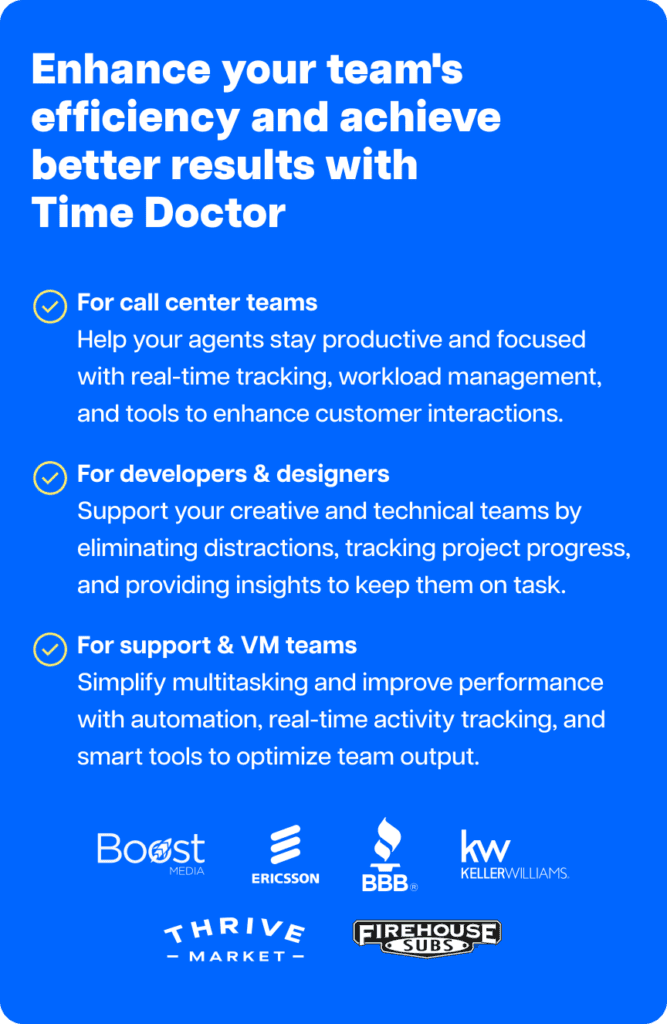What if you’re not busy… you’re just bleeding time?
Think about it. Over the past month, how many hours did your team spend multitasking, reacting to “urgent” fires, or waiting on status updates that never came? Was it 20 hours? 50? More? And did any of it feel like enough time to focus on what actually matters?
Now imagine if even 30% of that time had been used to set priorities, focus on high-impact work, and make measurable progress. What would that do for your quarter?
Time doesn’t show up as a line item on your balance sheet, but it disappears just as quickly as money, especially with constant social media pings stealing your focus.. In high-pressure industries such as healthcare, finance, insurance, and BPO, this hidden loss can lead to serious consequences.
It results in missed SLAs, delayed reports, and top performers burning out before anyone even notices.
As Bakker Elkhuizen puts it, “Time management is the process of organising and planning how to divide your time between specific activities and priorities. Effective time management helps leaders, entrepreneurs, and small business owners achieve their goals.”
The truth? High-performing leaders succeed by choosing time management tools and techniques that create visibility, encourage accountability through trust, and scale easily across teams.
When the right systems are in place, teams stay focused, managers lead with clarity, and results follow.
But what actually works?
In this article, we’ll walk through 7 proven time management techniques and 5 powerful tools that help you optimise your team’s time, uncover opportunities for better focus, and create momentum with less effort.
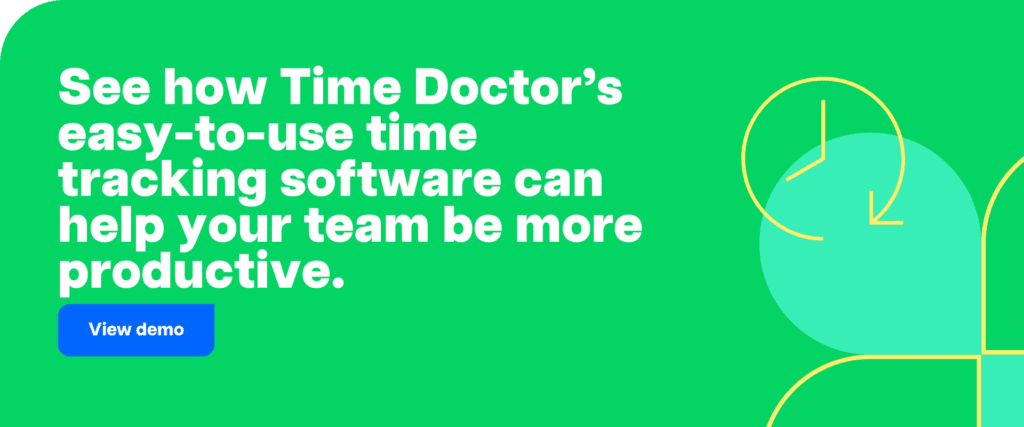
What we’ll cover
Let’s get started.
7 effective time management techniques
Here are seven proven time management strategies for people who need help getting things done:
1. Pomodoro technique
This time management technique, created by Francesco Cirillo, uses a timer to divide your work into 25-minute intervals. We call each interval a Pomodoro, after the tomato-shaped timer that Cirillo also created.
The Pomodoro technique teaches you to set goals and achieve them.
How it works
- Determine which task you want to accomplish.
- Set a timer for 25 minutes.
- Start the timer and focus fully to complete tasks during that session.
- Take a five-minute break. Go for a jog, return a few phone calls, have a coffee, or do something else that’s non-work-related.
- Then, set your timer for another 25-minute session and focus on another specific task.
- Repeat the process four times.
- The fifth time you start the process, you can take longer breaks of 20-30 minutes between each Pomodoro (25 minute session).
2. Eisenhower matrix
Learning to prioritize tasks based on urgency and impact is a critical time management skill, and this time management strategy can help you do that.
The Eisenhower Matrix was created by former American President Dwight Eisenhower as a commander in the army during World War II.
Due to the difficult decisions he had to make daily, he created this time management matrix to help him with prioritizing, deleting, and delegating tasks based on importance.
How it works
- Organize your tasks into four separate quadrants –
- Urgent tasks and important tasks/ projects to be completed first.
- Not urgent and important tasks/projects to be scheduled on your calendar.
- Urgent and unimportant tasks/projects to delegate to someone else.
- Not urgent and unimportant tasks/projects that you can delete.
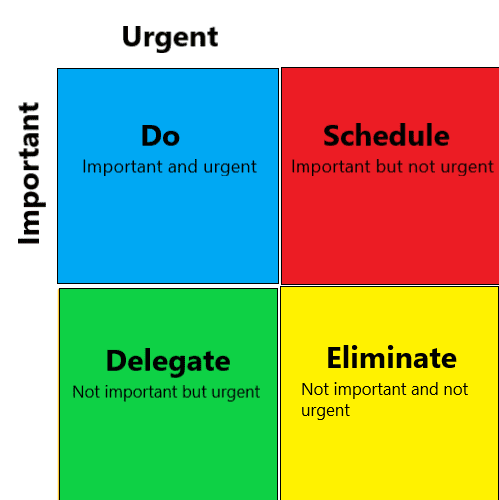
3. Eat that frog
Brian Tracy developed this time management technique with a simple premise: tackle your hardest and most important task first every morning.
The idea came from the Mark Twain quote, “Eat a live frog first thing in the morning, and nothing worse will happen to you the rest of the day.”
In his popular 2001 book Eat That Frog! 21 Great Ways to Stop Procrastinating and Get More Done in Less Time, Tracy says your action plan should focus on impact.
How it works
- Decide on your biggest goal and what you want to achieve most. Then, write it down.
- Define your key performance indicators.
- Set a deadline.
- Make a list of the things you need to do to achieve your goal, and order the list according to priority. Whatever’s first on the list is your “frogs.”
- Tackle your “frogs” first. If you have more than one frog, tackle the hardest, worst ones first.
- Do something the first thing every morning that moves you toward your goal. This way, no matter what happens later in the day, you know you’ve made progress towards your most important goal.
4. Time blocking
The time blocking technique is a flexible time management system that involves planning your day in advance using fixed time blocks. It works well alongside timeboxing, where you assign a set amount of time to each task and dedicate specific time “blocks” for various tasks and responsibilities.
It gives you the freedom to reserve time for specific work and create structure that helps increase productivity throughout the day.
How it works
- On a paper, write down blocks of time for each hour of the day. Your time blocks can be any amount of time you choose. For example, each time block can be 30 minutes, or it can be 1 hour – it’s up to you.
- Estimate how much time you’re going to take to complete each task and enter the task names into your daily schedule using time blocks
- So, you could divide your entire day into 30-minute time blocks and assign the first 30-minute block to eat breakfast.
- Then assign one or more 30-minute time blocks to other tasks you need to accomplish that day.
- Add buffer times between a few time blocks to allow for unexpected delays and tasks that unexpectedly take a lot of time.
Remember to assign your most important tasks to the time of day when you’re most productive, like in the morning.
Then, assign the less important tasks to the time of day when your energy levels aren’t as high.
5. Rapid Planning Method (RPM)
Here’s a time management strategy that aims to train your brain to focus on a vision of what you want. It’s proven highly effective in helping people achieve their long-term goals.
How it works
- This time management method starts with listing the tasks you plan to complete for the week.
- Then categorize your tasks based on similarities, such as personal or work-related activities. For example, you might place personal tasks together and organize work-related items into a separate group.
- Create your own RPM blocks by dividing a sheet of paper into three columns:
- The task
- The result you want from completing that task
- The purpose of completing it
- Then, list the actions you can take to accomplish the tasks.
6. 80/20 rule (Pareto analysis)
Italian economist Vilfredo Pareto created this time management technique on the premise that 20% of actions are responsible for 80% of outcomes.
The aim is to help you prioritize your tasks based on what will have the biggest impact and help you achieve your significant goals.
How it works
- List some of the issues or problems you have to address.
- Determine the root cause of each.
- Assign a score to each task based on its importance. Higher scores go to the tasks that have the greatest impact or value.
- Group similar tasks and problems together based on the root cause.
- Add up the score for each group.
- The group with the highest score is the issue you should tackle first.
7. SMART goal system
The SMART acronym stands for specific, measurable, attainable, relevant, and time-bound. It’s a good time management technique for people who have a larger goal that they want to achieve.
How it works
- Specific: Clearly and concisely define your goals so you know exactly what you need to do.
- Measurable: Use metrics, numbers, or smaller tasks that can help you measure your goals.
- Achievable /Attainable: Ensure that your goals are realistic and achievable.
- Relevant: Ensure that your goals align with your projects, different tasks, and long-term plans. You also need to set manageable tasks.
- Time-Bound: Make sure that your goals don’t take too long. Set time limits with a specific deadline.
To set SMART goals, you can start with a ready-made template, build your own tracking system, or use a method like GTD.
Once your goals are in place, you can use the six tools below to strengthen your time management and stay on track.
6 powerful time management tools
Here are six tools that can help skyrocket your time management efficiency:
1. Time Doctor for time tracking

Time Doctor is a powerful time tracker that combines time tracking with workforce analytics to help managers lead with trust and give teams visibility into how work gets done. It adds structure to time management by turning daily activity into clear, actionable insights.
With this visibility across remote, hybrid, and in-office teams, everyone stays focused, leaders make smarter decisions, and organizations achieve stronger results through better planning and performance.
Let’s take a look at Time Doctor key features.
A. Easy and flexible time tracking
Time Doctor makes time tracking simple for every workflow. Team members can start and stop tasks from their task list manually using a clean, distraction-free interface.
They can also choose automatic tracking, which runs quietly in the background from the moment the computer turns on.
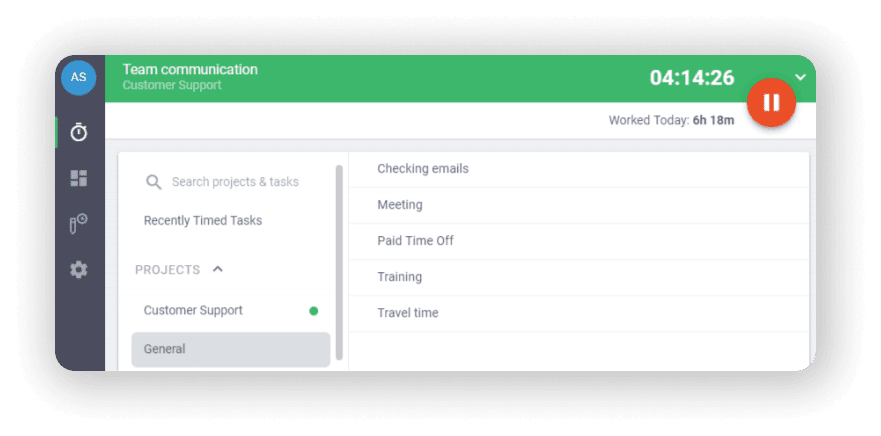
This flexible setup gives leaders accurate visibility into how time is spent across tasks, tools, and remote, hybrid, and in-office teams within a distributed workforce. It supports different work styles while keeping productivity data consistent and easy to understand.
B. Stay focused with real-time notifications
Time Doctor helps team members stay focused by sending gentle reminders when they become inactive. These prompts support accountability and promote daily habits that protect both productivity and well-being.
Idle time tracking reveals moments of distraction early. When combined with app and website data, it gives managers a clearer view of how work happens and where small changes can improve productivity.

C. Use productivity reports to improve performance
Time Doctor gives leaders at every level access to high-quality insights, including detailed Unusual Activity Reports that help surface workflow issues early. You can easily view:
- Timeline reports: See daily and weekly breakdowns of work time, break time, and focus trends
- Hours tracked: Understand how much time was logged across any timeframe
- Activity summaries: View levels of active, manual, or mobile time
- Project & task reports: Track how time aligns to priorities, clients, and outcomes
- Web & app usage: Spot trends across tools that support—or interrupt—focus
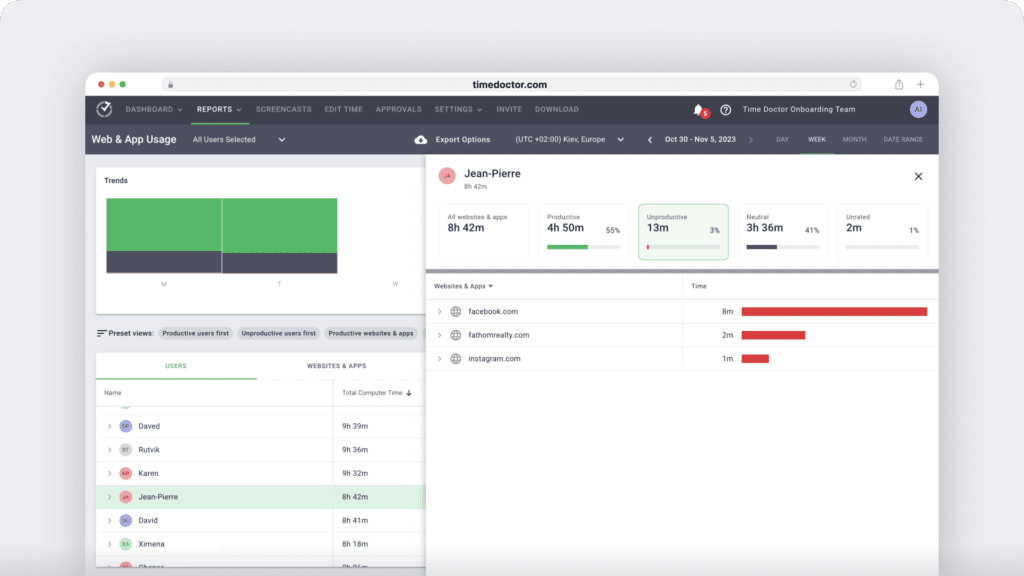
This data helps managers coach their teams more effectively, plan with confidence, and align performance with business goals through real-time insights instead of manual reporting.
Time Doctor also supports powerful integrations with your favorite project management, communication, and payroll tools, helping you streamline workflows without switching platforms.
Pricing
Time Doctor offers four flexible plans to match your team’s needs:
- Basic: $6.70 per user/month (billed annually) or $8 month-to-month
- Standard: $11.70 per user/month (billed annually) or $14 month-to-month
- Premium: $16.70 per user/month (billed annually) or $20 month-to-month
- Enterprise: Custom pricing available for advanced features and support
Every plan includes a 14-day free trial with no credit card required. All plans also support Attendance tracking, making it easier to manage schedules and stay compliant.
Customer ratings
2. Calendar for scheduling
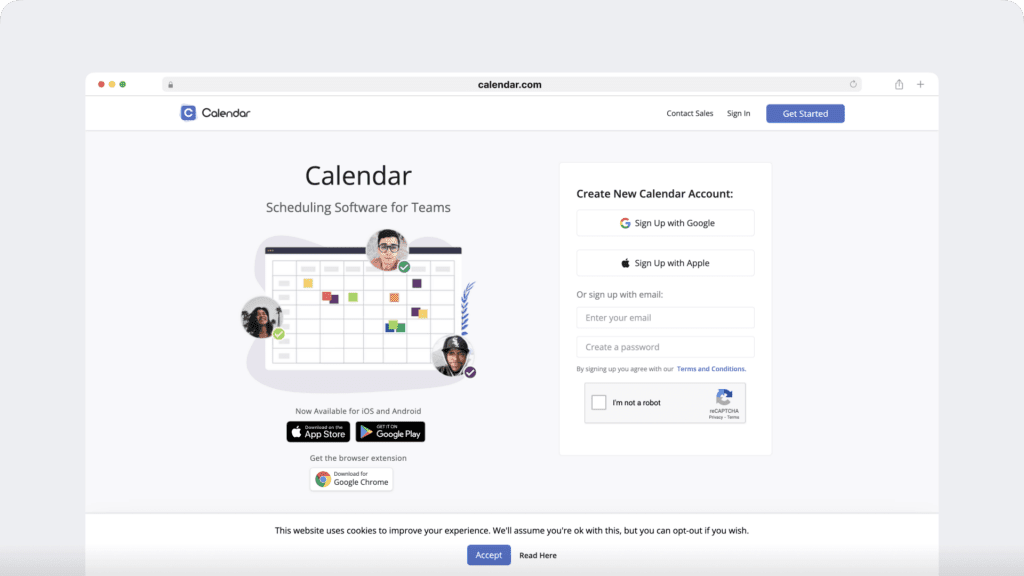
Calendar is a helpful time management tool that helps streamline scheduling, daily tasks, project planning, and client appointments, and efficiently plan out your workday without the need for back and forth emails. It’s a popular Google Calendar alternative.
Key features
- Create time slots for events and online meeting templates.
- Share calendar links with clients, employees, and anyone else.
- Anyone you’ve shared your calendar link with can then schedule meetings with you at the right time, based on your availability.
Pricing
Calendar offers four pricing tiers to suit different team sizes and scheduling needs
- Basic: Free forever
- Standard: $8 per user/month (billed annually, promotional rate)
- Pro: $12 per user/month (billed annually, promotional rate)
- Enterprise: Custom pricing for teams of 30+
Each paid plan includes a free trial, and all tiers allow users to connect multiple calendars based on the plan selected.
Customer ratings
- G2: 4.7/5 (71+ reviews)
- Capterra: n/a
3. Trello for task and project management
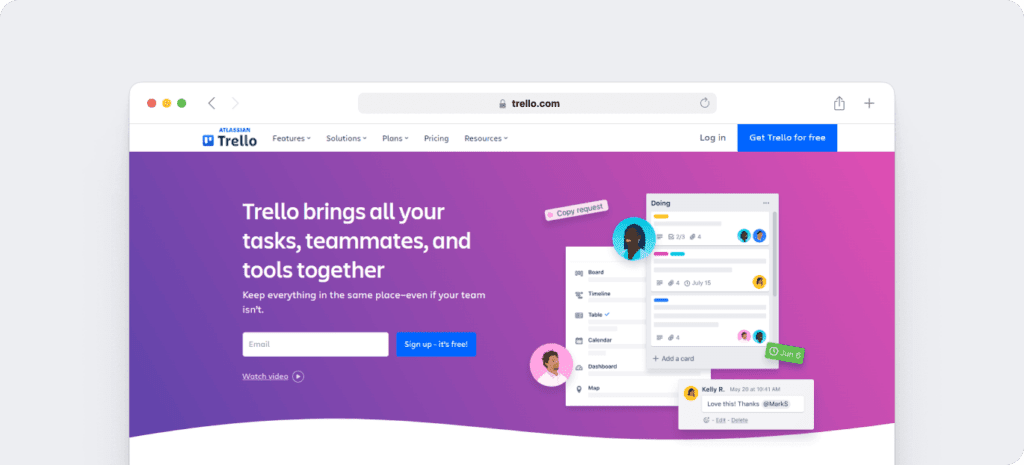
Trello is a well-known task management tool that uses Kanban boards and to-do lists to organise work visually. It’s a great option for project managers and teams, since everyone can easily see task progress and stay aligned.
Key features
- Automate tedious tasks and workflows with Trello’s Butler automation.
- Easily create a Gantt chart, Kanban visual, or time blocks for project tasks.
- Advanced checklists let you keep track of every single task within larger projects.
Pricing
Trello offers a range of plans to support individuals and teams
- Free: $0 – for up to 10 collaborators per workspace
- Standard: $5 per user/month (billed annually) or $6 monthly
- Premium: $10 per user/month (billed annually) or $12.50 monthly
- Enterprise: $17.50 per user/month (billed annually) with custom pricing for larger teams
Each plan includes access to core task management features, with advanced automation and admin tools available in higher tiers.
Customer ratings
- Capterra: 4.5/5 (23,180+ reviews)
- G2: 4.4/5 (13,570+ reviews)
4. Evernote for note taking
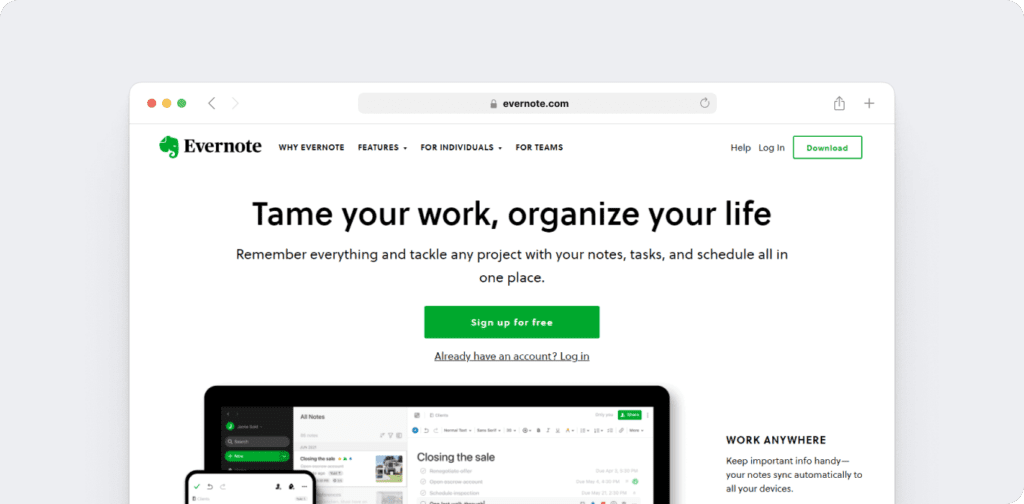
Evernote is a versatile note-taking and content organization app that helps you manage ideas, tasks, and projects with ease. You can create detailed digital notes, add attachments, save web clippings, and include audio, making it a perfect space to brainstorm and organize your ideas for better task management.
Key features
- Save time switching between devices by syncing and organizing your notes across all your devices.
- Save any web page, online article, or PDF file using the easy-to-use web clipper functionality.
- Search for specific data within handwritten notes and photos.
Pricing
Evernote offers flexible plans to support personal productivity and team collaboration
- Personal: $14.99 per month
- Professional: $17.99 per month
- Enterprise: Custom pricing available through Evernote’s Customer Success team
These plans include features for note-taking, project organization, file attachments, and enhanced task management.
Customer ratings
- G2: 4.4/5 (2000+ reviews)
- Capterra: 4.4/5 (8200+ reviews)
5. Momentum Dash for focus and inspiration

Momentum Dash is a free browser extension for Chrome, Firefox, Safari, and Edge that helps you stay focused and motivated throughout the day. It’s a great tool for creating a calm, distraction-free workspace that supports daily focus and deep work sessions.
Key features
- It shows your to-do list on your homepage. When you pull up a new tab, you get a reminder about what you should focus on.
- Receive daily inspiration in the form of quotes, mantras, and pictures on your computer.
- Let’s you start each day by entering the main thing you want to accomplish into the Daily Focus section.
Pricing
Momentum Dash is free. However, if you want to access additional features like widgets, you’ll have to upgrade to Momentum Plush.
Customer ratings
- G2: 4.8/5 (12+ reviews)
- Capterra: 4/5(1 review)
6. ProofHub for project management and team collaboration
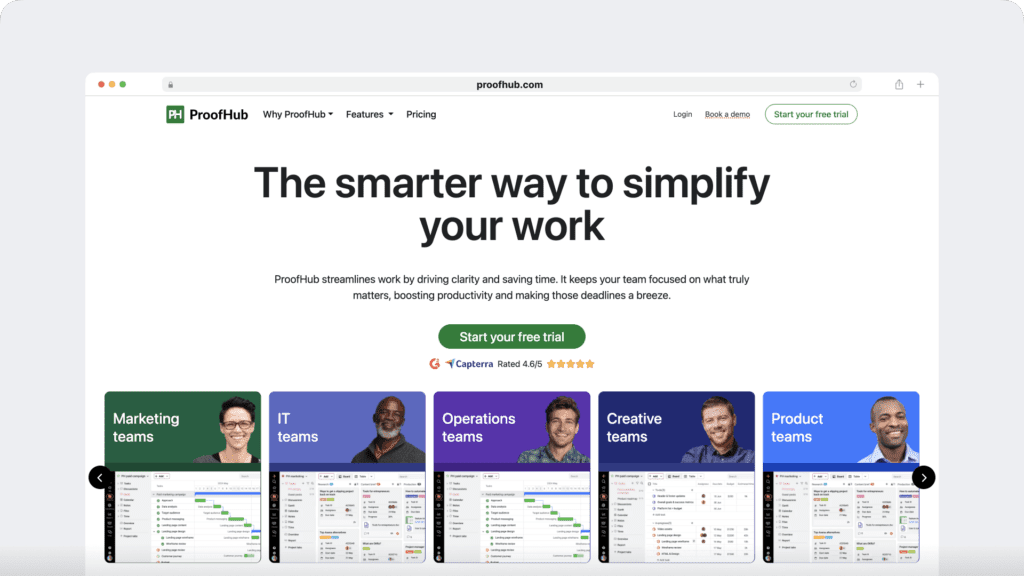
ProofHub is an all-in-one project management and team collaboration tool that brings everything you need into one place. You can easily organize projects, assign tasks, track time, and collaborate with your team in a streamlined workspace.
It’s a strong choice for teams who want to stay focused and productive without juggling multiple apps.
Key features
- Intuitive interface with no extra clutter to focus only on what matters.
- Flat pricing with no per-user fee, offering built-in chat, time-tracking, proofing, and more at no extra cost.
- Track progress against the estimated time and instantly get notified about any delays.
Pricing
ProofHub offers flat pricing with no per-user fees
- Essential: $45 per month, billed annually
- Ultimate Control: $89 per month, billed annually
Both plans support unlimited users. A 14-day free trial is available to explore all core features.
Customer ratings
- G2: 4.5/5 (90+ reviews)
- Capterra: 4.6/5 (100+ reviews)

Final thoughts
Strong time management starts with the right systems, including tools, techniques, and practical time management tips your team can actually use. But if you’re relying on disconnected apps and manual time tracking, you’re likely missing critical visibility into how work really gets done.
That’s where Time Doctor makes the difference.
With real-time employee time tracking, productivity analytics, and full transparency across teams and workflows, Time Doctor turns work patterns into insights you can act on.
Managers can lead with trust, coach with data, and use employee monitoring insights to stay ahead of burnout, bottlenecks, and missed goals.
What would change in your team if you could spot wasted time, align priorities faster, and simplify attendance, screen monitoring, and payroll tracking in one place?
Get a Demo to simplify workforce analytics and drive smarter decisions.

Carlo Borja is the Content Marketing Manager of Time Doctor, a workforce analytics software for distributed teams. He is a remote work advocate, a father and an avid coffee drinker.

